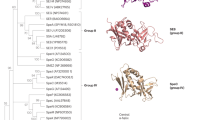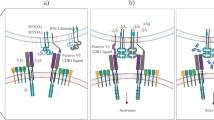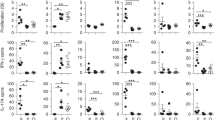Abstract
T CELLS bearing the αβ receptor can specifically react with target cells coated with staphylococcal enterotoxin and expressing major histocompatibility complex class II molecules; these responses depend on which variable region (V) of the receptor's β-subunit is used1–7. We have now examined whether a similar situation exists for human T cells bearing the γδ receptor. We found that reactivity to staphylococcal enterotoxin A is strictly dependent on the presence of the Vγ9 variable region in the γδ T-cell receptor (TCR). These cytotoxic responses required the expression of HLA class II molecules by the target cell and could be inhibited by anti-γδTCR and by anti-HLA-class-II monoclonal antibodies. In contrast to αβTCR+ cell clones, no proliferate response of Vγ9+ T-cell clones towards stimulator cells coated with enterotoxin A was observed in vitro. These results indicate that the γδTCR repertoire might be influenced by enterotoxin A produced during staphylococcal infections in vivo. This could provide a molecular basis for the observation that Vγ9+ T cells form the large majority of peripheral γδTCR+ cells but only a small proportion of thymic γδTCR+ cells.
This is a preview of subscription content, access via your institution
Access options
Subscribe to this journal
Receive 51 print issues and online access
$199.00 per year
only $3.90 per issue
Buy this article
- Purchase on Springer Link
- Instant access to full article PDF
Prices may be subject to local taxes which are calculated during checkout
Similar content being viewed by others
References
Janeway, C. A. & Katz, M. E. J. Immun. 134, 2057–2063 (1985).
Lynch, D. H., Cole, B. C., Bluestone, J. A. & Hodes, R. J. Eur. J. Immun. 16, 747–751 (1986).
Janeway, C. A. et al. Immunol. Rev. 107, 61–88 (1989).
Fleischer, B. & Schrezenmeier, H. J. exp. Med. 167, 1697–1708 (1988).
Kappler, J. W. et al. Science 244, 811–813 (1989).
Fleischer, B., Schrezenmeier, H. & Conradt, P. Cell Immun. 120, 92–101 (1989).
White, J. et al. Cell 56, 27–35 (1989).
Vietor, H. & Koning, F. Immunogenetics (in the press).
Koning, F., Knot, M., Wassenaar, F. & v.d. Elsen, P. Eur. J. Immun. 19, 2099–2105 (1989).
Bottino, C. et al. J. exp. Med. 168, 491–505 (1988).
Borst, J. et al. Eur. J. Immun. 19, 1559–1568 (1989).
Lanier, L. et al. Eur. J. Immun. 18, 1985–1992 (1988).
Jitsukawa, S. et al. J. exp. Med. 166, 1192–1197 (1987).
Triebel, F. et al. J. exp. Med. 167, 694–699 (1988).
Faure, F., Jitsukawa, S., Triebel, F. & Hercend, T. J. Immun. 140, 1372–1379 (1988).
Littman, D. R. et al. Nature 326, 85–88 (1987).
Krangel, M. S., Band, H., Hata, S., McLean, J. & Brenner, M. B. Science 237, 64–67 (1987).
Pelicci, P. G., Subar, M., Weiss, A., Dalla-Favera, R. & Littman, D.R. Science 237, 1051–1055 (1987).
Bergdoll, M. S. in Staphylococci and Staphylococcal Infections (eds Easmon, S. C. F. & Adlam, C.) 559–598 (Academic, London, 1983).
Chien, Y., Iwashima, M., Kaplan, K. B., Eliot, J. F. & Davis, M. M. Nature 327, 677–682 (1987).
Faure, F., Jitsukawa, S., Triebel, F. & Hercend, T. J. Immun. 141, 3357–3360 (1988).
Mingari, M. C. et al. Eur. J. Immun. 18, 1831–1834 (1988).
Kappler, J. W. Roehm, N. & Marrack, P. Cell 49, 273–280 (1987).
Kappler, J. W., Staerz, U. D., White, J. & Marrack, P. Nature 332, 35–40 (1988).
MacDonald, H. R. et al. Nature 332, 40–45 (1988).
Marrack, P. & Kappler, J. W. Nature 332, 840–843 (1988).
Koning, F. et al. Science 236, 834–837 (1987).
Kuziel, W. A. et al. Nature 328, 263–266 (1987).
Goodman, T. & Lefrançois, L. Nature 333, 855–858 (1988).
Augustin, A., Kubo, R. T. & Sim, G-K. Nature 340, 239–241 (1989).
Triebel, F. et al. Eur. J. Immun. 18, 2021–2027 (1988).
Goulmy, E. in HLA Typing: Methology and Clinical Aspects, 105–122 (CRC, New York, 1982).
Author information
Authors and Affiliations
Rights and permissions
About this article
Cite this article
Rust, C., Verreck, F., Vietor, H. et al. Specific recognition of staphylococcal enterotoxin A by human T cells bearing receptors with the Vγ9 region. Nature 346, 572–574 (1990). https://doi.org/10.1038/346572a0
Received:
Accepted:
Published:
Issue Date:
DOI: https://doi.org/10.1038/346572a0
This article is cited by
-
γδ T cells: origin and fate, subsets, diseases and immunotherapy
Signal Transduction and Targeted Therapy (2023)
-
Ligand recognition by the γδ TCR and discrimination between homeostasis and stress conditions
Cellular & Molecular Immunology (2020)
-
γδ-T cells: an unpolished sword in human anti-infection immunity
Cellular & Molecular Immunology (2013)
-
Diversity of γδ T-cell antigens
Cellular & Molecular Immunology (2013)
-
Peptide antigens for gamma/delta T cells
Cellular and Molecular Life Sciences (2011)
Comments
By submitting a comment you agree to abide by our Terms and Community Guidelines. If you find something abusive or that does not comply with our terms or guidelines please flag it as inappropriate.



